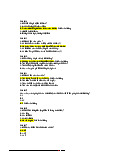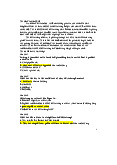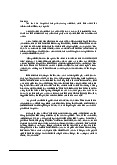















Preview text:
Câu h i 1 ỏ
In summary, for most visitors, the Japanese are (1) complex and difficult to
understand. The graceful act of (2) Bowing, is the traditional greeting. However,
they have also adopted the western custom of shaking hands, but with a light grip.
Meanwhile, to (3) show respect for their customs, it would flatter them to offer a
slight bow when being introduced. (4) avoid hugging and kissing when greeting. It is
considered rude to stare. Prolonged direct eye contact is considered to be (5)
impolite or even intimidating. It is rude to stand with your hand or hands in your
pockets, especially when greeting someone (6) or when addressing a group of
people. The seemingly simple act of exchanging business cards is more complex in
Japan (7) because the business card represents not only one's identity but also his
(8) status in life. Yours should be printed in your own language and in Japanese. The
Japanese are not a touch-oriented society; so avoid open displays of affection,
touching or any prolonged (9) form of body contact. Queues are generally
respected; especially in crowded train and subway stations (10) where the huge
volume of people causes touching and pushing.
The most dominant and reliable features of facial expressions provide a constant
channel of communication. They can be shifty and evasive; convey hate, fear, and guilt; or (1) confidence, love, and su express pport.
Referred to as "mirrors of the soul" our eyes serve as the major decisive
factor in (2) interpreting the spoken words. The eyes of the man converse as (3)
Much as their tongues, with the advantage that the ocular dialect needs (4)
No dictionary, but it is understood all over the world. When the eyes say one
thing, and the tongue another, a practiced man relies on eyes. Except (5)
For extremely shy individuals, most people look for social acceptance by studying
the eyes of others. Eyes also can (6) accurately indicate a positive or a negative
relationship. People tend to look longer and more often at the people whom they
trust, respect and care about than at those whom they doubt or (7) dislike .
Normal eye dilation is not under control of the individual. Personally characteristics 1
such as introversion and extroversion also influence eye behavior. Eye behavior seems (8)
particular importance and is ge to be
nerally used to indicate whether
one is open to communication. This can be observed when a teacher asks the class a
question: students who think they know the answer will generally (9) look at the
teacher, (10) while students who do not know the answer will usually try to avoid eye contact.
Many American customs will surprise you, the same thing happens to us when we (1)
Visit another country. People from various cultures handle many small daily things
differently. What a dull world it would be if this were not true!
Some differences are minor, and people soon become accustomed to them.
At (2) First , for example, some foreign women may be started at the idea of (3)
Having their hair or styled by men. Visitors may be amazed to see men wearing
wigs. People may (4) Find the transitory quality of much American life odd, for example, one (5)
rent art by the week or the en Can tire furnishings of an
apartment, from sofa and bed to the last spoon, on less than 8 hours’ notice.
In many cultures, people think that (1) love and marriage together – like bread
and wine or meat and (2) potatoes They think that love is a necessary foundation for (3)
and that you should love the pe marriage rson you marry before you get
married. In other (4) Cultures , however a man and a woman may not even know
each other before their wedding day. Romantic love is not bequeathed to marriage
in these cultures. These people expect that love will develop (5) After the
wedding if the marriage is a good one. Your views on love and marriage come from your culture.
Passage 3: Read the passages carefully, then choose the best option
Greetings in all languages have the same purpose: to establish contact with
another person, to recognize his or her existence and to show friendliness. The 2
formulas for greeting are very specific and usually do not carry any literal meaning
people say “ Good morning “even if it is a miserable day and may reply to “How are
you?” with “Fine, thanks” even if they aren’t feeling well.
Closings, like greetings are commonly used to exchange with no literal
meaning. People who are leaving each other permanently or for a long time shake
hands or embrace, depending on the relationship. If you are in an unfamiliar
situation and wonder what to do, watch other people or ask.
It is interesting, and sometimes very important to learn about the standards
of courtesy in different cultural areas of the world so that we can practice them
well and avoid awkwardness in case we get a chance to visit a person or a
community of unfamiliar social customs.
Which of the following is a characteristic of the formulas for greeting?
a. common Câu trả l i không đúng ờ b. specific c. usual d. literal
Which of the following is NOT mentioned in the passage as a purpose of greetings?
a. To show that you admire him or her. Câu trả lời đúng
b. To show that you recognize his or her present
c. To show that you are willing to be his or her friend.
d. To create contact with the person being gre
The passage is about ………. 3 a. the definition of culture
b. cultural differences Câu tr l ả i đúng ờ
c. the effects of cultures on love and marriage
d. the role of spouses in the family
The word It (line 3) refers to …………. a. structure b. framework c. family d. culture
In what way are closings similar to greeting? a. They are exchanges
b. They have no literal meaning Câu tr l ả i đúng ờ c. They are familiar d. They are common.
When people plan to marry, they expect to find in their partner not only a lover
but a friend also. They find a person with whom they can share their opinions, their
emotions, thoughts and fears. In marriage we are looking for a partner who will be
able to understand our values, our likes and dislikes. 4
If a man and a woman are born and raised in the same country, most likely
they are familiar with the same songs, movies, jokes, books and life in general.
They basically have the same roots. In the case of a western man and foreign
woman family everything is more complicated and requires much more patience and
understanding from both spouses. On one hand each of the partners has an
opportunity to learn a great deal about the other's country, culture, traditions and
life styles which can be very interesting. On the other hand it can be very
disappointing if there is the inability to understand your partner's excitements and
frustrations. For example, you are watching the television and suddenly you see a
famous actor or singer, or other type of an artist whose name you have grown up
with. Maybe this artist was an idol for your parents and the music of this artist
was often played in your house when you were a child. Unfortunately you realize
that your wife is unable to understand your feelings because she has no idea who
this artist is. Her eyes are absolutely empty because she has never even heard the
song before. You feel rather disappointed! Remember that your wife has the same
situation with you. You do not know her country's songs, her country's famous
actors, her books. She has her own memories and in actuality, for her, everything
is much more difficult than it is for you. At least, you live in your own country
where everybody can understand you. She lives in completely strange surroundings,
where she has nobody to share her feelings with, except you.
Do some research and learn about your wife's country, culture and lifestyles.
Talk with her, ask her questions, get to know what songs she likes, what movies and
books are of interest to her. The Internet will give you a great opportunity to find
anything! Tell her about your country's culture, let her listen to the music that you
like, rent a movie for her that left you with great impression. Let her understand
you better through the things that you like. Patience and time will help you to fight cultural differences.
If there is the inability to understand a spouse's excitements and frustrations the
marriage, he or she may feel …………... a. faithful b. happy 5 c. hopeless
d. disappointed Câu tr l ả i đúng ờ The passage is ……….. a. apologetic b. convincing c. critical d. advisory
According to the passage, ………..
a. Spouses who are from different cultures need more patience and understanding
in their marriage than those who have the same roots.
b. Spouses who have the same nationality need more patience and understanding in
their marriage than those who are from different cultures.
c. Spouses who are from different cultures can never share anything together.
d. Spouses who have the same roots go not share anything together.
To overcome cultural differences in marriage needs …………..
a. patience and time Câu trả lời đúng b. time and money c. movies and music . d. books and the Internet 6
Traditions, saying, beliefs, language, and values are just a few things that make
up our culture. Culture is the framework in which families are structured. It
shapes our expectations and ideals. Culture plays a part in the meaning of marriage
and our roles as husbands, wives, children and parents.
Understanding cultural differences and similarities related to marriage is
important. Culture affects the roles that spouses take within marriages, the age at
marriage and number of children a couple have, the meaning of divorce,
cohabitation and non-marital childbearing, and the way parents raise children.
Understanding how relationships and marriages vary across cultural contexts, and
how they are similar, we will be able to identify the unique ways that marriages and
family life affect people of various cultures. As a result, we will be able to help
families and sustain happy marriages.
A cross cultural marriage or similar love relationship can be extremely
exciting. The cultural background, visits to the other country, the language of the
country and learning to speak it, the different habits and ways of doing and saying
things that people from other cultures have, are all very exciting indeed. What are
the disadvantages of a cross cultural marriage or love relationship with someone
from another country or cultural background? No matter how much you love your
husband or wife, no matter how high your level of cross cultural awareness, cross
cultural communication and respect for differences, misunderstanding seems to be unavoidable.
The passage is about ………. a. the definition of culture
b. cultural differences Câu tr l ả i đúng ờ
c. the effects of cultures on love and marriage
d. the role of spouses in the family 7
If you are invited to an American friend’s home for dinner, remember these
general rules for polite behaviour. First of all, arrive approximately on time but not
early. Americans expect promptness. It will be all right to be 10 or 15 minutes late,
but not 45 minutes late. When you are invited to someone’s home for meal, it is
polite to bring a small gift. Flowers and candy are always appropriate. If you have
something attractive made in your country, your host or hostess will certainly
enjoy receiving that gift. What will you do if you are served some food that you
cannot eat or you do not like? Do not make a fuss about it. Simply eat what you can
and hope that no one noticed it. Be sure to complement the cook on the food that
you are enjoying. Do not leave immediately after dinner, but do not over-stay your
welcome, either. The next day, call or write a thank- you note to say how much you enjoyed the evening.
When you come to someone’s house for dinner, ……….. a. do not care about gifts b. bring a lot of gifts
c. bring some flowers, candy or something made in your native country. Câu tr ả l i đúng ờ
d. You should never offer any gift
If your companion insists on paying his share, ……… a. It will be impolite.
b. you should get into argument with him c. Do not agree.
d. you should let him pay as he expects. Which sentence is NOT true? 8 a. you should not overstay
b. you should not leave immediately after dinner
c. You should not compliment the cook on the food Câu tr l ả i đúng ờ
d. You should not make someone notice that you do not like the food..
To make a reservation, you …………………………
a. have to give your address, the time you arrive and how many persons there are in your group.
b. just give your name, the time you arrive and your address.
c. just give your name, the time you arrive and how many persons there are in your group. Câu tr l ả i đúng ờ
d. just give your name, the time you arrive and your telephone number.
When you invite someone to have dinner, you……. a. share the bill with him
b. should prepare to pay the bill.
c. Only the speaker let him to pay himself. d. give the bill to him
If you are invited to American friend’s home, …………. a. politeness is not necessary b. Câu tr
Punctuality is appreciated ả lời đúng c. you should go late a bit 9
d. you should be late at least 45 minutes
Body postures and movements are frequently indicators of self-confidence,
energy, fatigue, or status. Cognitively, gestures operate to clarify, contradict, or
replace verbal messages. Gestures also serve an important function with regard to
regulating the flow of conversation. For example, if a student is talking about
something in front of the class, single nods of the head from the teacher will likely
cause that student to continue and perhaps more elaborate. Postures as well as
gestures are used to indicate attitudes, status, affective moods, approval,
deception, warmth, arid other variables related to conversation interaction.
The saying "A picture is worth a thousand words" well describes the meaning
of facial expressions. Facial appearance - including wrinkles, muscle tone, skin
coloration, and eye color-offers enduring cues that reveille information about age,
sex, race, ethnic origin, and status.
A less permanent second set of facial cues-including length of hair,
hairstyle, cleanliness, and facial hair-relate to an individual's idea of beauty. A
third group of facial markers are momentary expressions that signal that cause
changes in the forehead, eyebrows, eyelids, cheeks, nose, lips, and chin, such as
raising the eyebrows, wrinkling the brow, curling the lip.
Some facial expressions are readily visible, while others are fleeting. Both types
can positively or negatively reinforce the spoken words and convey cues concerning emotions and attitudes. Gestures ………..
a. can end a conversation more quickly than usual
b. can do nothing with a conversation
c. can clarify the meaning of verbal messages.
d. may interrupt the flow of a conversation 10
According to the writer, "A picture is worth a thousand words" means ………
a. facial gestures can convey a lot of meanings
b. a picture is more important than a thousand words Câu trả lời đúng
c. a picture of a face is more valuable than a thousand words
d. he has just bought a picture with a thousand words on it
A nod of the head from the teacher will likely ask his student to ………. what he is saying. a. Throw away
b. go on Câu trả lời đúng c.give up d. put off
How many categories of facial expressions are mentioned? a. 5 b. 4
c. 3 Câu trả lời đúng d. 2
In many modern countries, people think of a family as a mother, a father and their
children. But this is not the only kind of the family group. In some parts of the
world, a family group has many other members. This kind of large family is called an
"extended family" or a "joint family". 11
The joint family includes all living relatives on either the mother's or the
father's side of the family. It is made up of grandparents, parents, brothers,
sisters, uncles, aunts, and cousins. They live together in a large house or in huts built close together.
Early people probably lived in joint families. They had to be part of a large
group in order to survive. The members of the group helped each other hunt. They
worked together to protect themselves from dangerous animals and other enemies.
In China, people lived in joint families. When a son married, he and his wife
lived at his parents' home. Unmarried daughters remained at home until they
married. Chinese children felt very loyal to their parents. Younger members of the
joint families always took care of the old ones.
In India and Africa, some people still live in joint families. The members of a
joint family share their earnings and property. If one member of the group
becomes ill or has bad luck, the others help the person. As in the past, the
members of the joint family offer each other help and protection.
According to the passage, people who live in joint families often….
a. remain at home until they married
b. take care of one another Câu trả lời đúng
c. share their good or bad luck
d. feel very loyal to their parents
This passage as a whole tells us about … a. joint families
b. families found in India and Africa c. All types of family 12 d. families in China
Long time ago, members of joint families ………..
a. helped each other catch animals
b. lived separately in order to survive
c. found it difficult to live together d. did not live together
The phrase "is made up of” in paragraph 2 could be best replaced by ………… a. consists b. includes c. compensates d. forms
The American education system requires that students complete 12 years of
primary and secondary education prior to attending university or college. This may
be accomplished either at public or government-operated schools, or at private
schools. These 12 years of schooling or their equivalent may also be completed
outside the USA, thus giving foreign students the opportunity to pursue the
benefits of the American education system and obtain a quality American
education. Perhaps one of the most impressive facts is that a large number of
presidents, prime ministers and leaders from other countries have experienced the
American education system and graduated from a university or school in the USA.
In many fields and industries, the American education system offers the most
cutting-edge, sought-after programs at the world's best schools. That is why 13
graduating from an accredited American school and being exposed to the rigors of
the American education system is an investment in your future.
Whether you want to study at a top USA university, a top USA college, a
vocational or high school, a thorough understanding of how the American education
system works is essential. Without a clear grasp of the American education
system, an international student will find it difficult to make the right academic
choices. It is no surprise that the American education system and the American
school system host more international students than any other country in the world! What is the writer's advice?
a. International students should have a thorough understanding of how the
American education system works before going there to study Câu trả lời đúng
b. International students should not study at a top USA university, a top USA
college, a vocational or high school.
c. Without a clear grasp of the American education system, an international
student can make the right academic choices
d. International students should not invest their future education in the US.. Which is true?
a. Many leaders all over the world have studied in the US.
b. Foreign students are not offered opportunities in the US:
c. The US education is not good enough for foreign students. Câu trả lời không đúng
d. There are not many foreign students in the US.
According to the text, students in the USA ………… 14
a. needn't take primary and secondary education
b. do not necessarily take primary and secondary education in the country
c. are made to take primary and secondary education in the country
d. spend less than 12 years for primary and secondary education
The writer ………… the US education. a. appreciates b. overstates c. underestimates d. dislikes
In the past, both men and women were expected to be married at quite young
ages. Marriages were generally arranged by parents and family, with their children
having little chance to say no in the matter. In the past it was not surprising to
find that a bride and groom had only just met on the day of their engagement or marriage.
In modern Vietnam, this has changed completely as people choose their own
marriage-partners based on love, and in consideration primarily to their own needs
and wants. Moreover early marriage is quite illegal.
The traditional Vietnamese wedding is one of the most important of
traditional Vietnamese occasions. Regardless of westernization, many of the age-
old customs practiced in a traditional Vietnamese wedding continue to be
celebrated by both Vietnamese in Vietnam and overseas, often combining both
western and eastern elements. Besides the wedding ceremony, there is also an
engagement ceremony which takes place usually half a year or so before the
wedding. Due to the spiritual nature of the occasion, the date and time of the
marriage ceremony are decided in advance by a fortune teller. The traditional 15
Vietnamese wedding consists of an extensive array of ceremonies: the first is the
ceremony to ask permission to receive the bride, the second is the procession to
receive the bride (along with the ancestor ceremony at her house), the third is to
bring the bride to the groom's house for another ancestor ceremony and to
welcome her into the family, then the last is a wedding banquet. The number of
guests in attendance at these banquets is huge, usually in the hundreds. Several
special dishes are served. Guests are expected to bring gifts, often money, which
the groom and bride at one point in the banquet will go from table to table collecting.
In former days, the fact that a bride and groom had only first met just on the day
of their engagement or marriage was ……….. a. strange
b. popular Câu trả lời đúng c. surprising. d. uncommon
Which does not exist in a Vietnamese wedding party? a.guests b. gifts c. firecrackers d. dishes 16



